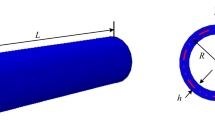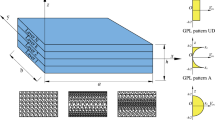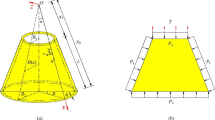Abstract
This paper firstly presents numerical analyses of functionally graded porous plates/shells with graphene platelets (GPLs) reinforcement using a novel four-node quadrilateral element with five degrees of freedom per node, namely SQ4P, based on the first-order shear deformation theory and Chebyshev polynomials. The novelty of the present element is to use the high-order shape functions which satisfy the interpolation condition at the points based on Chebyshev polynomials to build the new flat four-node element for analysis of plate/shell structures. The Chebyshev polynomials are a sequence of orthogonal polynomials that are described recursively and the values of these polynomials belong to the interval [−1,1] as well as vanish at the Gauss points. Full Gauss quadrature rule is used to establish the stiffness matrix, geometric stiffness matrix, mass matrix and load vector. Various dispersions of GPLs and internal pores into the metal matrix through the thickness of structure are considered with the rule of a mixture and the Halpin–Tsai model for evaluating effective material properties across the thickness. The influence of weight fraction, porosity coefficient and dimensions of GPLs, distribution of GPLs and porosity into metal matrix are fully studied via several numerical examples from static bending to free vibration and buckling response. Numerical results and comparison with other solutions from available references suggest that the present element has enough reliability and validity to use in structural analysis. With regular and irregular meshes, these results are in close agreement with the exact solutions by using the suitable value for the order of the shape functions.



























Similar content being viewed by others
References
Betts, C.: Benefits of metal foams and developments in modelling techniques to assess their materials behaviour: a review. Mater. Sci. Technol. 28(2), 129–143 (2012)
Lefebvre, L.-P., Banhart, J., Dunand, D.C.: Porous metals and metallic foams: current status and recent developments. Adv. Eng. Mater. 10(9), 775–787 (2008)
Kulshreshtha, A., Dhakad, S.K.: Preparation of metal foam by different methods: a review. Mater. Today: Proc. 26, 1784–1790 (2020)
Rajan, V.S., et al.: Influence of metal foam properties on performance of polymer composite spur gear. Mater. Today: Proc. 24, 1244–1250 (2020)
Smith, B.H., et al.: Steel foam for structures: a review of applications, manufacturing and material properties. J. Constr. Steel Res. 71, 1–10 (2012)
Pompe, W., et al.: Functionally graded materials for biomedical applications. Mater. Sci. Eng. A 362(1), 40–60 (2003)
Watari, F., et al.: Biocompatibility of materials and development to functionally graded implant for bio-medical application. Compos. Sci. Technol. 64(6), 893–908 (2004)
Marx, J.C., et al.: Polymer infused composite metal foam as a potential aircraft leading edge material. Appl. Surf. Sci. 505, 144114 (2020)
Yang, X., et al.: Design and operating evaluation of a finned shell-and-tube thermal energy storage unit filled with metal foam. Appl. Energy 261, 114385 (2020)
Zhang, J., et al.: A theoretical study of low-velocity impact of metal foam-filled circular tubes. Thin-Walled Struct. 148, 106525 (2020)
Sardari, P.T., et al.: Energy recovery from domestic radiators using a compact composite metal Foam/PCM latent heat storage. J. Cleaner Prod. 257, 120504 (2020)
Tong, X., et al.: Degradation behavior, cytotoxicity, hemolysis, and antibacterial properties of electro-deposited Zn–Cu metal foams as potential biodegradable bone implants. Acta Biomater. 102, 481–492 (2020)
Catanzano, O., et al.: Macroporous alginate foams crosslinked with strontium for bone tissue engineering. Carbohyd. Polym. 202, 72–83 (2018)
Ferreira, F.V., et al.: Porous nanocellulose gels and foams: Breakthrough status in the development of scaffolds for tissue engineering. Mater. Today 37, 126–141 (2020)
Manakari, V., et al.: Evaluation of wear resistance of magnesium/glass microballoon syntactic foams for engineering/biomedical applications. Ceram. Int. 45(7, Part A), 9302–9305 (2019)
Liu, P.S., Ma, X.M.: Property relations based on the octahedral structure model with body-centered cubic mode for porous metal foams. Mater. Des. 188, 108413 (2020)
Olszowska, K., et al.: Three-dimensional nanostructured graphene: synthesis and energy, environmental and biomedical applications. Synth. Met. 234, 53–85 (2017)
Li, K., et al.: Isogeometric Analysis of functionally graded porous plates reinforced by graphene platelets. Compos. Struct. 204, 114–130 (2018)
Iijima, S.: Helical microtubules of graphitic carbon. Nature 354(6348), 56–58 (1991)
Gong, L., et al.: Optimizing the reinforcement of polymer-based nanocomposites by graphene. ACS Nano 6(3), 2086–2095 (2012)
Ghodrati, H., Ghomashchi, R.: Effect of graphene dispersion and interfacial bonding on the mechanical properties of metal matrix composites: an overview. FlatChem 16, 100113 (2019)
Pattnaik, S., Kumar Sutar, M.: Graphene base nanocomposites: an overview. Mater. Today: Proc. 18, 5432–5437 (2019)
Liew, K.M., Kai, M.F., Zhang, L.W.: Carbon nanotube reinforced cementitious composites: an overview. Compos. A Appl. Sci. Manuf. 91, 301–323 (2016)
Mubarak, N.M., et al.: An overview on methods for the production of carbon nanotubes. J. Ind. Eng. Chem. 20(4), 1186–1197 (2014)
Zhao, S., et al.: Functionally graded graphene reinforced composite structures: a review. Eng. Struct. 210, 110339 (2020)
Boehm, H.P., et al.: Surface properties of extremely thin graphite lamellae. In: Proceedings of the Fifth Conference on Carbon. Pergamon, pp. 73–80 (1962).
Novoselov, K.S., et al.: Electric field effect in atomically thin carbon films. Science 306(5696), 666 (2004)
Novoselov, K.S., et al.: Two-dimensional gas of massless Dirac fermions in graphene. Nature 438(7065), 197–200 (2005)
Novoselov, K.S., et al.: Room-temperature quantum hall effect in graphene. Science 315(5817), 1379 (2007)
Geim, A.K., Novoselov, K.S.: The rise of graphene. Nat. Mater. 6(3), 183–191 (2007)
Geim, A.K.: Graphene: status and prospects. Science 324(5934), 1530 (2009)
Balandin, A.A., et al.: Superior thermal conductivity of single-layer graphene. Nano Lett. 8(3), 902–907 (2008)
Kuilla, T., et al.: Recent advances in graphene based polymer composites. Prog. Polym. Sci. 35(11), 1350–1375 (2010)
Rafiee, M.A., et al.: Enhanced mechanical properties of nanocomposites at low graphene content. ACS Nano 3(12), 3884–3890 (2009)
Zaman, I., et al.: From carbon nanotubes and silicate layers to graphene platelets for polymer nanocomposites. Nanoscale 4(15), 4578–4586 (2012)
Tiwari, S.K., et al.: Graphene research and their outputs: status and prospect. J. Sci. Adv. Mater. Dev. 5(1), 10–29 (2020)
Bui, T.Q., et al.: On the high temperature mechanical behaviors analysis of heated functionally graded plates using FEM and a new third-order shear deformation plate theory. Compos. B Eng. 92, 218–241 (2016)
Hu, X., et al.: A new cohesive crack tip symplectic analytical singular element involving plastic zone length for fatigue crack growth prediction under variable amplitude cyclic loading. Eur. J. Mech. A. Solids 65, 79–90 (2017)
Ton-That, H.L., Nguyen-Van, H., Chau-Dinh, T.: An improved four-node element for analysis of composite plate/shell structures based on twice interpolation strategy. Int. J. Comput. Methods 17(06), 1950020 (2020)
Ton That, H.L., Nguyen-Van, H., Chau-Dinh, T.: Nonlinear bending analysis of functionally graded plates using SQ4T elements based on twice interpolation strategy. J. Appl. Comput. Mech. 6(1), 125–136 (2020)
That-Hoang, L.T., et al.: Enhancement to four-node quadrilateral plate elements by using cell-based smoothed strains and higher-order shear deformation theory for nonlinear analysis of composite structures. J. Sandwich Struct. Mater. (2018). https://doi.org/10.1177/1099636218797982
Ton-That, H.L.: Improvement on eight-node quadrilateral element (IQ8) using twice-interpolation strategy for linear elastic fracture mechanics. Eng. Solid Mech. 8(4), 323–336 (2020)
Ton-That, H.L., Nguyen-Van H.: A combined strain element in static, frequency and buckling analyses of laminated composite plates and shells. Period. Polytech. Civ. Eng. 65(1), 56–71 (2021)
Ton-That, H.L., Nguyen-Van, H., Chau-Dinh, T.: Static and buckling analyses of stiffened plate/shell structures using the quadrilateral element SQ4C. Comptes Rendus. Mécanique 348(4), 285–305 (2020)
Nguyen-Van, H., Mai-Duy, N., Karunasena, W., Tran-Cong, T.: Buckling and vibration analysis of laminated composite plate/shell structures via a smoothed quadrilateral flat shell element with in-plane rotations. Comput. Struct. 89(7–8), 612–625 (2011)
Nguyen-Van, H., Nguyen-Hoai, N., Chau-Dinh, T., Tran-Cong, T.: Large deflection analysis of plates and cylindrical shells by an efficient four-node flat element with mesh distortions. Acta Mech. 226(8), 2693–2713 (2015)
Phung-Van, P., et al.: Nonlinear transient isogeometric analysis of smart piezoelectric functionally graded material plates based on generalized shear deformation theory under thermo-electro-mechanical loads. Nonlinear Dyn. 87(2), 879–894 (2017)
Phung-Van, P., et al.: Porosity-dependent nonlinear transient responses of functionally graded nanoplates using isogeometric analysis. Compos. B Eng. 164, 215–225 (2019)
Phung-Van, P., et al.: Isogeometric analysis of functionally graded carbon nanotube-reinforced composite plates using higher-order shear deformation theory. Compos. Struct. 123, 137–149 (2015)
Phung-Van, P., et al.: An efficient computational approach for control of nonlinear transient responses of smart piezoelectric composite plates. Int. J. Non-Linear Mech. 76, 190–202 (2015)
Phung-Van, P., et al.: An isogeometric approach for size-dependent geometrically nonlinear transient analysis of functionally graded nanoplates. Compos. B Eng. 118, 125–134 (2017)
Thanh, C.-L., et al.: The size-dependent thermal bending and buckling analyses of composite laminate microplate based on new modified couple stress theory and isogeometric analysis. Comput. Methods Appl. Mech. Eng. 350, 337–361 (2019)
Thanh, C.-L., et al.: Isogeometric analysis for size-dependent nonlinear thermal stability of porous FG microplates. Compos. Struct. 221, 110838 (2019)
Thanh, C.-L., et al.: Isogeometric analysis of functionally graded carbon nanotube reinforced composite nanoplates using modified couple stress theory. Compos. Struct. 184, 633–649 (2018)
Thanh, C.-L., Ferreira, A.J.M., Abdel Wahab, M.: A refined size-dependent couple stress theory for laminated composite micro-plates using isogeometric analysis. Thin-Walled Struct. 145, 106427 (2019)
Nguyen, H.X., et al.: A refined quasi-3D isogeometric analysis for functionally graded microplates based on the modified couple stress theory. Comput. Methods Appl. Mech. Eng. 313, 904–940 (2017)
Atroshchenko, E., et al.: Weakening the tight coupling between geometry and simulation in isogeometric analysis: from sub- and super-geometric analysis to Geometry-Independent Field approximaTion (GIFT). Int. J. Numer. Meth. Eng. 114(10), 1131–1159 (2018)
Marussig, B., et al.: Fast isogeometric boundary element method based on independent field approximation. Comput. Methods Appl. Mech. Eng. 284, 458–488 (2015)
Yu, T., et al.: A stabilized discrete shear gap extended finite element for the analysis of cracked Reissner–Mindlin plate vibration problems involving distorted meshes. Int. J. Mech. Mater. Des. 12(1), 85–107 (2016)
Videla, J., et al.: h- and p-adaptivity driven by recovery and residual-based error estimators for PHT-splines applied to time-harmonic acoustics. Comput. Math. Appl. 77(9), 2369–2395 (2019)
Hu, Q., et al.: Skew-symmetric Nitsche’s formulation in isogeometric analysis: dirichlet and symmetry conditions, patch coupling and frictionless contact. Comput. Methods Appl. Mech. Eng. 341, 188–220 (2018)
Nguyen, V.P., et al.: Isogeometric analysis: An overview and computer implementation aspects. Math. Comput. Simul. 117, 89–116 (2015)
Natarajan, S., Manickam, G.: Bending and vibration of functionally graded material sandwich plates using an accurate theory. Finite Elem. Anal. Des. 57, 32–42 (2012)
Natarajan, S., et al.: Natural frequencies of cracked functionally graded material plates by the extended finite element method. Compos. Struct. 93(11), 3082–3092 (2011)
Natarajan, S., et al.: Size-dependent free flexural vibration behavior of functionally graded nanoplates. Comput. Mater. Sci. 65, 74–80 (2012)
Natarajan, S., et al.: Linear free flexural vibration of cracked functionally graded plates in thermal environment. Comput. Struct. 89(15), 1535–1546 (2011)
Natarajan, S., et al.: Analysis of functionally graded material plates using triangular elements with cell-based smoothed discrete shear gap method. Math. Probl. Eng. 2014, 247932 (2014)
Natarajan, S., et al.: A parametric study on the buckling of functionally graded material plates with internal discontinuities using the partition of unity method. Eur. J. Mech. A. Solids 44, 136–147 (2014)
Xiang, T., et al.: Free vibration and mechanical buckling of plates with in-plane material inhomogeneity: a three dimensional consistent approach. Compos. Struct. 118, 634–642 (2014)
Mathew, T.V., Natarajan, S., Martínez-Pañeda, E.: Size effects in elastic-plastic functionally graded materials. Compos. Struct. 204, 43–51 (2018)
Nguyen-Xuan, H., et al.: A node-based smoothed finite element method with stabilized discrete shear gap technique for analysis of Reissner–Mindlin plates. Comput. Mech. 46(5), 679–701 (2010)
Nguyen-Xuan, H., et al.: Isogeometric analysis of functionally graded plates using a refined plate theory. Compos. B Eng. 64, 222–234 (2014)
Nguyen-Xuan, H., et al.: A smoothed finite element method for plate analysis. Comput. Methods Appl. Mech. Eng. 197(13), 1184–1203 (2008)
Valizadeh, N., et al.: NURBS-based finite element analysis of functionally graded plates: static bending, vibration, buckling and flutter. Compos. Struct. 99, 309–326 (2013)
Thai-Hoang, C., et al.: A cell — based smoothed finite element method for free vibration and buckling analysis of shells. KSCE J. Civ. Eng. 15(2), 347–361 (2011)
Thai, C.H., et al.: Isogeometric analysis of laminated composite plates using the higher-order shear deformation theory. Mech. Adv. Mater. Struct. 22(6), 451–469 (2015)
Nguyen-Thanh, N., et al.: Isogeometric analysis using polynomial splines over hierarchical T-meshes for two-dimensional elastic solids. Comput. Methods Appl. Mech. Eng. 200(21), 1892–1908 (2011)
Nguyen-Thanh, N., et al.: An alternative alpha finite element method with discrete shear gap technique for analysis of isotropic Mindlin-Reissner plates. Finite Elem. Anal. Des. 47(5), 519–535 (2011)
Yin, S., et al.: Isogeometric locking-free plate element: A simple first order shear deformation theory for functionally graded plates. Compos. Struct. 118, 121–138 (2014)
Zrahia, U., Bar-Yoseph, P.: Plate spectral elements based upon Reissner–Mindlin theory. Int. J. Numer. Meth. Eng. 38(8), 1341–1360 (1995)
Sprague, M.A., Purkayastha, A.: Legendre spectral finite elements for Reissner–Mindlin composite plates. Finite Elem. Anal. Des. 105, 33–43 (2015)
Brito, K.D., Sprague, M.A.: Reissner–Mindlin Legendre spectral finite elements with mixed reduced quadrature. Finite Elem. Anal. Des. 58, 74–83 (2012)
Patera, A.T.: A spectral element method for fluid dynamics: Laminar flow in a channel expansion. J. Comput. Phys. 54(3), 468–488 (1984)
Kim, S., Kim, S.D.: Preconditioning on high-order element methods using Chebyshev–Gauss–Lobatto nodes. Appl. Numer. Math. 59(2), 316–333 (2009)
Dang-Trung, H., Yang, D.-J., Liu, Y.C.: Improvements in shear locking and spurious zero energy modes using Chebyshev finite Element Method. J. Comput. Inf. Sci. Eng. 19(1), 011006 (2018)
Liu, Z., et al.: Nonlinear behaviour and stability of functionally graded porous arches with graphene platelets reinforcements. Int. J. Eng. Sci. 137, 37–56 (2019)
Li, Z., Zheng, J.: Analytical consideration and numerical verification of the confined functionally graded porous ring with graphene platelet reinforcement. Int. J. Mech. Sci. 161–162, 105079 (2019)
Reza Barati, M., Zenkour, A.M.: Post-buckling analysis of refined shear deformable graphene platelet reinforced beams with porosities and geometrical imperfection. Compos. Struct. 181, 194–202 (2017)
Yang, J., Chen, D., Kitipornchai, S.: Buckling and free vibration analyses of functionally graded graphene reinforced porous nanocomposite plates based on Chebyshev–Ritz method. Compos. Struct. 193, 281–294 (2018)
Nguyen, Q.H., et al.: A three-variable high order shear deformation theory for isogeometric free vibration, buckling and instability analysis of FG porous plates reinforced by graphene platelets. Compos. Struct. 245, 112321 (2020)
Nguyen, N.V., et al.: A novel computational approach to functionally graded porous plates with graphene platelets reinforcement. Thin-Walled Structures 150, 106684 (2020)
Zhou, Z., et al.: Accurate nonlinear buckling analysis of functionally graded porous graphene platelet reinforced composite cylindrical shells. Int. J. Mech. Sci. 151, 537–550 (2019)
Ansari, R., Torabi, J., Hasrati, E.: Postbuckling analysis of axially-loaded functionally graded GPL-reinforced composite conical shells. Thin-Walled Struct. 148, 106594 (2020)
Occorsio, D., Themistoclakis, W.: Uniform weighted approximation on the square by polynomial interpolation at Chebyshev nodes. Appl. Math. Comput. 385, 125457 (2020)
Yamagishi, M.: A note on Chebyshev polynomials, cyclotomic polynomials and twin primes. J. Number Theory 133(7), 2455–2463 (2013)
Kim, P., et al.: An error embedded method based on generalized Chebyshev polynomials. J. Comput. Phys. 306, 55–72 (2016)
Sahmani, S., Fattahi, A.M., Ahmed, N.A.: Analytical treatment on the nonlocal strain gradient vibrational response of postbuckled functionally graded porous micro-/nanoplates reinforced with GPL. Eng. Comput. 36, 1559–1578 (2019)
Gao, K., et al.: Nonlinear free vibration of functionally graded graphene platelets reinforced porous nanocomposite plates resting on elastic foundation. Compos. Struct. 204, 831–846 (2018)
Ebrahimi, F., Dabbagh, A.: Vibration analysis of multi-scale hybrid nanocomposite plates based on a Halpin–Tsai homogenization model. Compos. B Eng. 173, 106955 (2019)
Wang, Y., et al.: Bending and elastic vibration of a novel functionally graded polymer nanocomposite beam reinforced by graphene nanoplatelets. Nanomaterials (Basel, Switzerland) 9(12), 1690 (2019)
Cong, P.H., Duc, N.D.: New approach to investigate the nonlinear dynamic response and vibration of a functionally graded multilayer graphene nanocomposite plate on a viscoelastic Pasternak medium in a thermal environment. Acta Mech. 229(9), 3651–3670 (2018)
Boyd, J.P., Ong, J.R.: Exponentially-convergent strategies for defeating the Runge Phenomenon for the approximation of non-periodic functions, part two: multi-interval polynomial schemes and multidomain Chebyshev interpolation. Appl. Numer. Math. 61(4), 460–472 (2011)
Boyd, J.P., Xu, F.: Divergence (Runge Phenomenon) for least-squares polynomial approximation on an equispaced grid and Mock-Chebyshev subset interpolation. Appl. Math. Comput. 210(1), 158–168 (2009)
Fox, D.D., Simo, J.C.: A drill rotation formulation for geometrically exact shells. Comput. Methods Appl. Mech. Eng. 98(3), 329–343 (1992)
Taylor, R.L., Auricchio, F.: Linked interpolation for Reissner-Mindlin plate elements: part II—A simple triangle. Int. J. Numer. Meth. Eng. 36(18), 3057–3066 (1993)
Nguyen-Thoi, T., et al.: A cell-based smoothed discrete shear gap method using triangular elements for static and free vibration analyses of Reissner–Mindlin plates. Int. J. Numer. Meth. Eng. 91(7), 705–741 (2012)
SP Timoshenko and J. Gere, Theory of Elasticity, ed. 3rd. 1970, New York: McGraw-Hill.
Noguchi, H., Kawashima, T., Miyamura, T.: Element free analyses of shell and spatial structures. Int. J. Numer. Meth. Eng. 47(6), 1215–1240 (2000)
Author information
Authors and Affiliations
Corresponding author
Ethics declarations
Conflict of interest
On behalf of all authors, the corresponding author states that there is no conflict of interest.
Additional information
Publisher's Note
Springer Nature remains neutral with regard to jurisdictional claims in published maps and institutional affiliations.
Rights and permissions
About this article
Cite this article
Ton-That, H.L., Nguyen-Van, H. & Chau-Dinh, T. A novel quadrilateral element for analysis of functionally graded porous plates/shells reinforced by graphene platelets. Arch Appl Mech 91, 2435–2466 (2021). https://doi.org/10.1007/s00419-021-01893-6
Received:
Accepted:
Published:
Issue Date:
DOI: https://doi.org/10.1007/s00419-021-01893-6




